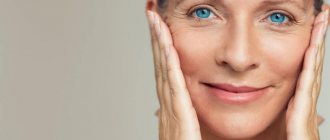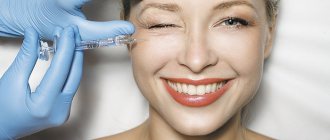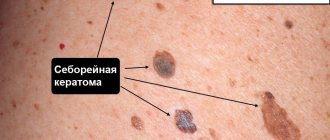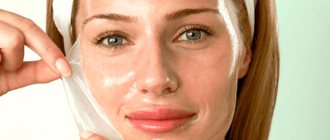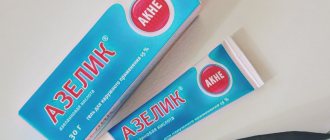In the life of every woman, the second “transitional” age begins - menopause. This is an important period between the reproductive period and complete suppression of ovarian function. The transition to menopause begins at approximately 45-47 years of age and lasts from 2 to 10 years. Estrogens are extremely important hormones for the skin. Receptors for female sex hormones are found in keratinocytes, melanocytes, fibroblasts and other skin cells. A sharp decrease in the level of circulating hormones during menopause inevitably affects the activity of hormone-dependent cells. Age-related changes in the skin due to hormonal changes and deficiency of estrogen and progesterone in women during menopause are called menopausal or biological aging of the skin.
What processes occur in the skin when it loses elasticity?
Young skin is elastic and elastic. It does not deform under mechanical influence. If you squeeze or stretch it, it will retain its structure without damage (elasticity) and quickly return to its original shape (elasticity).
Why does this happen?
The dermis, its supporting layer, which is located between the epidermis and subcutaneous fat, is responsible for the firmness, elasticity, and strength of the skin. The dermis is a connective tissue that consists of collagen, elastin and hyaluronic acid.
These substances are the main components of youthful skin. Collagen and elastin are proteins that form a natural framework in the form of intertwined fibers. Hyaluronic acid creates a moist environment for them.
- Collagen fibers
work like the spring frame of a mattress: they return the tissue to its original shape after compression. - Elastin fibers
run diagonally at different angles and thus hold the dermis together, keeping its components from separating. - Hyaluronic acid
provides skin hydration, which is also necessary for smoothness and elasticity. It helps moisture retain in the skin in the form of a kind of gel. One molecule of hyaluronic acid is capable of attracting and holding up to 10 molecules of water in the intercellular space so that it does not all come out (through the pores of the skin we lose up to half a liter of liquid per day). In addition, hyaluronic acid protects against toxins.
But over the years, the structure of the dermis is disrupted. What leads to this?
- Blood circulation slows down,
the delivery of oxygen and nutrients to skin cells deteriorates, and their metabolism is disrupted. - Lymphatic circulation suffers,
excess fluid accumulates in the tissues of the face, it swells, and the skin becomes loose. - At some point, a hormonal factor comes into play:
the level of estrogen – “beauty hormones” – decreases. The number of fibroblasts - cells that participate in the synthesis of collagen, elastin and hyaluronic acid - directly depends on them.
All this is reflected on the skin:
- In the dermis, the renewal of collagen, elastin, and hyaluronic acid worsens (due to a reduction in the number of fibroblasts).
The quality of available fibers deteriorates. Elastin becomes fragile and breaks, collagen loses its properties.Result: the skin loses firmness, elasticity, strength, ability to retain moisture, and becomes defenseless against toxins.
- In addition to hyaluronic acid, the hydro-lipid mantle is responsible for skin moisture and its protection from the environment.
This is a film that covers the top layer of skin. It consists of the products of the activity of the sebaceous and sweat glands (located in the dermis). Over the years, this water-fat layer becomes thinner as the activity of the glands decreases. Result: dryness and dehydration. - Changes also occur in the deepest layer of the skin - subcutaneous fat (hypodermis).
It becomes thinner, while the area of the skin remains the same, that is, part of the integument turns out to be “extra.” Result: sagging skin. - In addition, the dermis is penetrated by blood and lymphatic vessels, nerve endings, sebaceous and sweat glands. The deterioration of their condition also affects the loss of skin elasticity.
Types of skin irregularities and causes of their appearance
You need to know the enemy by sight. Therefore, first learn about various skin diseases that are accompanied by structural disturbances, deformation of the surface layer of the dermis and the formation of bumpy facial skin.
- Enlarged pores - ducts of sweat and sebaceous glands emerge through small points on the skin (pores). When there is excess production, the pores stretch, become inflamed at the edges, and rolls of dense tissue form.
- Acne and its consequences - It has been proven that the main cause of acne is hormonal imbalance. The body has an increased sensitivity to the sex hormone testosterone and responds by increasing the production of fat by the sebaceous glands. As a result, the ducts of the glands become clogged, and a dense, enlarging formation appears in this place. If an infection gets into the ducts, rapid infection occurs and an inflammatory process develops with ulcers and dense bumps on the surface. Demodicosis leads to such consequences. This disease is caused by tiny mites that penetrate enlarged pores or sebaceous glands.
- Scars and cicatrices - occur as a result of cuts, injuries, burns of the face, and prolonged inflammatory processes. In places of scars, the skin loses its collagen, elastic tissues are replaced by dense fibrous inserts. They deform the surface and disrupt all functions of the epidermis.
- Hyperpigmentation - ultraviolet rays in high doses cause sunburn of tissue. As a result, not only rough spots appear, but also the production of your own hyaluronic acid, and, consequently, collagen synthesis stops. All skin restoration processes are disrupted.
- Inflammation - any inflammatory processes require gentle treatment. “It will go away on its own” means that the process may result in the appearance of scars and unwanted deformities.
These are the main reasons. You can calculate them yourself, but you still cannot do without additional diagnostics, so do not neglect the capabilities of modern laboratories in cosmetology.
Why does facial skin lose elasticity?
Skin elasticity decreases with age. The processes begin at the age of 25-30. During menopause (+/- 50 years), when the level of estrogen in a woman’s body drops, they accelerate. The skin becomes flabby and thin, becomes covered with wrinkles, and sags.
You can go through this quarter-century-long journey in different ways, when the prerequisites for skin aging already exist, but hormones have not yet delivered their verdict: “There is no reproductive function, there is no point in being attractive to a partner.”
How you go this path depends 99% on you, your lifestyle and habits. You can look 50 at 35, and vice versa. Choose what you like best.
What factors influence the loss of elasticity in facial skin?
- Poor posture
What is the connection between your posture and the elasticity of your facial skin? Very strong connections. Poor posture is a hunched back, hunched shoulders, a forward head, a tight and shortened neck. And this whole structure of chronically tense and stiff muscles prevents blood from flowing to the face, lymph from draining from it, and facial muscles from being in healthy tone.The skin becomes flabby, sagging on the cheeks and eyelids, a double chin forms, and the oval of the face floats down.
- Excess ultraviolet radiation
Passion for tanning (sun, solarium) leads to photoaging of the skin. It hits on several fronts at once, but the loss of skin elasticity is mainly affected by a blow to collagen and elastin. Ultraviolet light penetrates the dermis, promotes the formation of free radicals, which, in turn, destroy collagen and elastin fibers.According to one version, 70% of the skin ages not from age, but from exposure to sunlight. Their harmful effects accumulate in the body almost from childhood.
- Excessive physical and mental stress
Stress, overwork, nervous exhaustion, lack of sleep, physical overexertion - all these are prerequisites for a sagging face. - Unhealthy nutrition
Your skin is harmed by “food waste,” overeating, aggressive diets, lack of nutrients, fiber, vitamins, and minerals. - Fluid deficiency
In order for moisture to be retained in the dermis, you need not only a sufficient amount of high-quality hyaluronic acid, but also an uninterrupted source of water. The liquid enters the body in the form of a drink. If you do not drink enough clean water (less than 2 liters per day), the skin will become dry and flabby. - Smoking and alcohol
Nicotine, tar, and alcohol poison the skin with toxins, dry it out and deprive it of its protective properties. This also applies to cigarette smoke: passive smoking also steals youth from your face.The skin becomes thin and dry, like tissue paper. Elasticity is the ability to withstand mechanical stress. If you crumple such paper, it will never straighten itself out again.
- Lack of physical activity
Movement is not only life, but also youth. Lack of movement means slower blood circulation, worsening metabolism, poor cell regeneration and loss of skin elasticity. - Sharp fluctuations in body weight
Gained weight - the skin stretched, lost weight - the skin sagged. - Hormonal disorders
The “beauty hormone” - estrogen - determines the production of fibroblasts and the synthesis of collagen, elastin, and hyaluronic acid with their help. If the level of female hormones drops, the skin loses its “youthful” characteristics. Naturally, the amount of estrogen decreases after menopause, but hormonal disruptions can also occur during reproductive age. - Poor environment and aggressive natural factors
In addition to the sun, dirty and dry air, frost, wind, and dust also harm the skin. - Punitive cosmetology
Any external invasion - surgical methods, threads, Botox injections, contouring - is stressful for the skin. In addition, tissues wean themselves from working independently. When the effect of the procedure subsides, all the negative processes that were happening inside burst out. The skin becomes sluggish, flabby, thin, dry, wrinkles and creases multiply and worsen. - Improper cosmetic care
If the skin does not receive sufficient cleansing, moisturizing and nutrition, it ages prematurely. Also a challenge for her is the abuse of decorative cosmetics. - Pathologies
The condition of the skin can worsen due to disturbances in the functioning of the nervous, endocrine, cardiovascular systems, gastrointestinal tract, etc.
We have counted 13 main reasons for skin loss of elasticity. And this is the best tip for those who want to delay and minimize the aging of their face.
Contrary to numerology, we suggest you make our top 13 the basis for your work on yourself, so that all misfortunes and failures will bypass your skin.
Read below in which directions you should move.
Professional treatments
- Laser peeling or facial resurfacing uses the property of a laser beam to stimulate the skin's production of its own collagen. This allows you to remove shallow wrinkles and scars. The procedure lasts twenty minutes and is painless. After finishing, the skin turns red. Recovery takes seven to ten days. The method can only be performed in a trusted clinic by an experienced doctor. To eliminate deep bumps, the penetration of the rays must be sufficient. Doctors know the capabilities of their device and will recommend the mode and frequency of procedures.
- Ultrasonic cleaning - with the help of hardware ultrasound, impaired functions of the skin are restored (inflammation is relieved, allergic reactions are eliminated, collagen and elastin synthesis is enhanced). Cleaning removes dead skin cells of the epidermis, smoothes it, and promotes the penetration of active ingredients from masks and creams. It is recommended as a cleansing procedure for relatively unpronounced skin unevenness.
- The method of disincrustation using galvanic current allows for cleansing at a deeper level and gets rid of old seals. First, an alkaline solution is applied and the treatment is first carried out with a negative current; after seven to ten minutes the charge changes to positive. This relaxes the ducts of the sebaceous glands, allows the accumulated secretions to escape, and relieves inflammation.
- Mesotherapy - the active ingredient is one of the preparations based on hyaluronic acid. It is administered by injection with a thin needle into the tissue according to the scheme. In this case, under visual control, the missing agent responsible for tissue reconstruction, hydration, and elasticity is returned to the skin. There is a fight against inflammatory changes. A course of treatment requires six to eight procedures. It needs to be repeated twice a year.
- Chemical peeling. Deep resurfacing is a procedure at the surgical level, performed in a hospital setting once in a lifetime. Requires a fairly long recovery period. In cosmetic hospitals, superficial chemical peeling using acids (lactic, mandelic, glycolic, salicylic) is widely used. Allows you to remove unnecessary dead cells. Rejuvenate tissues and straighten tubercles, activating its own regeneration processes. Before the procedure, preparation is necessary using products with weak fruit acids. This improves the effect of chemical peeling. It is recommended in the autumn, as thin skin becomes extremely susceptible to sunlight.
How to deal with uneven skin and achieve significant results? Take your time. This will be a major mistake. If you decide to undergo serious treatment, use the advice of professionals. You can’t apply everything at once or overload the skin: this will only weaken its protective properties. Start with home care and be patient; with the right approach, improvement will definitely come.
Prevention of loss of facial skin elasticity
Do you want to prolong the youth of your face?
- The first piece of advice is to watch your posture.
How do you sit at the computer: do you slouch, pull your head forward, lean your elbows to one side?Do you like to read while lying down?
Do you sleep on a soft mattress and high pillows, on one side or face down?
How much time do you spend on gadgets, hunched over and pressing your chin into your chest?
All this is harmful to your back, shoulders, neck and, as a result, to the elasticity of your facial skin.
- Do not overuse sunbathing and solariums.
Limit your time in direct sunlight. Use creams with UV filters, sunglasses, and wear hats with large brims. - Move a lot
An adult needs 30-60 minutes of moderate-intensity activity every day. Medium is one in which the heart rate increases, but can be maintained for more than 10 minutes. The most accessible option for such a load is walking (at least 7,000 steps per day).We also run, jump, swim, ride a bike, and play sports games.
All this is necessary to ensure that the muscles are in healthy tone, blood and lymph flow through the vessels without delay, and no excess fat or swelling puts pressure on the musculoskeletal system and does not pull the facial tissues down.
- Follow food and drinking regimes
Eliminate “food waste” from your diet, don’t overeat, don’t starve, ensure that you get all the necessary nutrients, fiber, vitamins, and microelements from your food.For youthful and elastic skin, it is useful to consume foods containing silicon, iron, selenium, zinc and the entire list of vitamins from A to P.
Drink at least 2 liters of clean water per day - this will create the basis for your skin and muscles to be elastic and hydrated.
By eating right, you will also eliminate weight fluctuations that are harmful to skin elasticity.
- Give up bad habits
Do not smoke or abuse alcohol - do not allow toxic substances into your body that lead to dehydration, thinning of the skin, loss of turgor and elasticity.
And some tips for caring for your skin.
What useful habits should you develop to keep your skin elastic for as long as possible:
- Take care of your face with cosmetics twice a day.
Morning and evening, cleanse, moisturize and nourish.To cleanse, use mild products that will not dry out your skin. The ideal option is to wipe your face with a cotton pad soaked in hydrosol (plant distillate).
To moisturize and nourish, choose natural products: oils, balms, squalane. They contain many useful, anti-aging components.
Choose hydrolates, oils, squalanes and balms from the Beauty365 brand at www.beauty365.ru. Find a detailed guide to the means below.
- Do gymnastics and self-massage of the face
Exercises and self-massage can be done at any age: both teenagers and women after menopause. If you are over 30, they should become a mandatory part of your beauty ritual.This is the basis for natural rejuvenation, a direct effect on the skin, muscles, blood vessels, lymph without injections or scalpels. The causes of skin aging are eliminated from the inside.
Make it a rule to knead your face along massage lines for 10-15 minutes a day, reduce swelling and perform simple exercises. At a young age, it is enough to do this 2 times a week.
If the problem of loss of skin elasticity has already become apparent, classes should be daily, the course should be at least three weeks.
- Perform self-massage with a dry brush (drybrushing) and vacuum cups
The jar and brush improve blood circulation, remove lymph, and tighten the skin. The brush also removes dead scales, which promotes skin renewal.It is better to alternate jars and brush. It is enough to perform the procedure 1-2 times a week.
Choose the Beauty365 Dry Facial Brush, which is made with boar bristles, and Beauty365 glass jars. They can be found at www.beauty365.ru.
How to perform the procedures?
Vacuum self-massage with cups.
Apply squalane or oil to your face for easy sliding of the cans (choose suitable Beauty365 products at www.beauty365.ru) and repeat the technique from the video:
Dry massage with a brush.
Rub clean and dry facial skin along the massage lines (indicated on the packaging of the Beauty365 dry facial brush). After the procedure, nourish the skin with cream, oil or squalane.
Reasons for the appearance of formations and their types
The causes of bumpy facial skin can be very different depending on the nature of the disorder. For example, enlarged pores are a problem that is often hereditary or associated with disturbances in the functioning of the sebaceous glands. The most common problem identified is for skin types characterized by increased oiliness.
In addition, increased sweating rates can expand the pores, contributing to their contamination. In the future, this will result in acne formations, and it becomes especially common for teenagers, because changes in hormonal levels often result in changes in the balance of the structure of the skin.
Lumpy skin can also result from the formation of ulcers, which are often the result of a special type of mite penetrating through enlarged pores. They can cause irritation and stimulate some infectious processes. In this case, pimples can be white or look like black dots. White lesions are most susceptible to inflammation, while blackheads rarely become inflamed. However, the degree of inflammation or its absence at any stage will be a prerequisite for the formation of uneven skin.
Often, people who play sports and put stress on themselves notice the appearance of porous areas on their facial skin. In other words, the skin has become lumpy. This is due to the fact that active loads and training activate the enhanced function of the sebaceous glands, provoking the expansion of pores.
Some people try to hide inflamed areas of facial skin with cosmetics and do it in vain, since some of them not only do not hide defects well enough, but also have an inflammatory effect and can lead to the formation of purulent accumulations in the form of acne. Oily compositions can generally contribute to the occurrence of allergies and rashes on the face.
How to restore elasticity to facial skin through surgery
Cosmetologists and plastic surgeons have two main solutions to any problem of facial aging: pricking and cutting.
Also with skin elasticity. How can I get it back? The most effective salon methods are considered to be radical methods - surgical ones.
In fact, they are dangerous to health, destructive to the skin and speed up its withering. Let's figure out why you shouldn't cut the skin.
Plastic surgeons offer to tighten facial skin in two ways: using surgical lifting and thread lifting.
What is the essence of the procedures?
Surgical lift:
excess skin is cut off, the remainder is stretched and sutured.
Thread lifting:
punctures are made in the skin, and artificial threads with notches are inserted into the soft tissues, which dissolve within a year. The effect is achieved due to tissue injury by threads and their subsequent scarring. In place of the threads, a pathological, fibrous frame is formed - “wrong” collagen, overgrown and damaged.
It doesn’t take a rocket scientist to understand that neither procedure improves the structure of the skin. On the contrary, they only create conditions for its accelerated aging, thinning, loss of firmness and elasticity. Self-regulation mechanisms are disrupted, and all processes deteriorate: from nourishing the cells of the dermis to renewing its “building material”.
Like any surgical intervention, skin tightening and thread lifting are traumatic operations. Complications are possible, including tissue and vessel necrosis, damage to the facial nerve, skin loss, blood clot formation, etc.
In addition to surgery, the following are also offered for face lifting:
- injection techniques: contour plastic surgery (fillers), mesotherapy, plasma lifting,
- hardware techniques: laser, radio waves, electric currents, light, cold, etc.
None of them solve the problem of loss of elasticity. At best, it creates a temporary effect, but even this does not always happen. Most likely, the skin condition will only worsen.
What to do then?
What is uneven complexion
An uneven complexion can cause the following problems:
- age spots (pigmentation);
- spider veins (rosacea);
- rashes (acne, rosacea, seborrheic dermatitis);
- post-inflammatory spots;
- tired skin, “smoker’s skin”.
These signs can occur either individually or combined with each other, as, for example, in the case of photoaging of the skin. This problem is characterized by a “variegated” appearance due to numerous age spots, spider veins and skin atrophy.
Is it possible to restore elasticity to facial skin?
Is your face already starting to look like a slowly deflating balloon? Is your skin loose and uneven? Are the contours blurry? Does gravity pull flaccid and stretched tissue down?
Flabby skin is not a death sentence. You can increase the elasticity and tighten the skin of your face. Moreover, only self-massage and gymnastics techniques will be effective. Only they will eliminate the causes of skin aging and launch the mechanisms of natural rejuvenation. They are safe, and the result will be visible after 2-3 weeks of regular exercise.
It's never too late to start doing exercises. Natural rejuvenation techniques can improve skin elasticity at any age.
The sooner you start taking care of your face, the easier it will be to restore elasticity to your skin and prolong youth.
The result will be even after menopause, when the problem has already been fixed at the hormonal level. You can tighten sagging skin, make the oval of your face clear, get rid of a double chin, bulldog cheeks, ptosis (drooping) of the upper eyelids.
Diagnostics
Endocrinologists are most often involved in identifying the causes of coarsening facial features. Taking into account the identified symptoms, the patient may be referred for consultation to an orthopedist, infectious disease specialist, or dermatologist. During the interview, the specialist finds out when the symptom appeared, which parts of the face underwent changes, and how quickly the manifestations progressed.
As part of the external examination, the doctor evaluates the proportions of the face and body, detects an increase in the size and deformation of individual structures, and identifies other symptoms: infiltrates, blue or reddening of the skin, dilated blood vessels. Women undergo a gynecological examination. An additional examination program may include:
- Hormone analysis
. It is the main study for confirming acromegaly, masculinization and virile syndrome. In case of acromegaly, the level of somatotropin is examined after an oral glucose test, and insulin-like growth factor is determined. Women are tested for cortisol, testosterone, follicle-stimulating and luteinizing hormones. - MRI of the pituitary gland.
Acromegaly and some variants of virile syndrome are caused by pituitary tumors. The study makes it possible to detect even small neoplasias ranging in size from 1-3 mm. - Sonography
. Necessary for suspected hormonally active neoplasia causing hyperandrogenism. An ultrasound of the female genital organs and an ultrasound examination of the adrenal glands are performed. - Studies in mucopolysaccharidoses
. Urine tests are performed to determine glycosaminoglycans, and enzyme activity is studied. Patients are referred for consultations to a psychiatrist, cardiologist, gastroenterologist and other specialists. - Radiography
. Indicated for patients with mucopolysaccharidosis. Confirms the presence of skeletal deformities characteristic of a particular type of disease. It makes it possible to determine the severity of orthopedic disorders and select the optimal treatment tactics. - Tests for leprosy
. To detect mycobacteria of leprosy, a bacterioscopic examination of skin scrapings at the site of the lesion, a histological analysis of the tissue of the lymph nodes and leprosy tubercles are carried out. To differentiate the form of leprosy, a test for lepromin, tests with mustard plaster, histamine, and nicotinic acid are performed. - Tests for rhinophyma
. Microscopy confirms a large number of epithelial cells and sebum. To confirm the diagnosis and exclude oncological lesions, cytological and histological examinations are performed.
Examination by an endocrinologist
Review of products to improve facial skin tone
In order not to spoil the results of self-massage and gymnastics, you also need to reconsider your lifestyle, habits, and cosmetic care.
Basic recommendations can be found above, in the chapter “Prevention of loss of elasticity in facial skin.”
A few more tips on choosing cosmetics.
- Cleansing
You should cleanse your facial skin in the morning and evening. From dirt, excess fat, cosmetics. The product should be soft, and ideally also moisturize.Hydrolates – plant distillates – are perfect for this. They remove everything unnecessary from the face well and at the same time provide optimal water balance. You can wipe your face with cotton pads soaked in hydrolate several times a day and not be afraid of drying it out. Such products are suitable not only for cleansing, but also for toning and moisturizing the skin.
Depending on your skin type, you can choose mint, lavender or sage hydrosol from Beauty365 at www.beauty365.ru.
- Anti-aging care
To increase skin elasticity, you need anti-aging cosmetics. A rich cocktail of vitamins and fatty acids, beneficial for youth, contain natural products: oils, squalane, balms.For morning care it is better to use squalane. These are light oils that absorb quickly and leave no residue.
Before going to bed, you can afford a more powerful product: oil or balm.
In the Beauty365 assortment you will find squalane (sugar cane), coconut oil, camellia sasanqua oil, Verbena hemp balm (oil and oil extracts of hemp, coconut, shea butter, pistachio, calendula, carrot seeds).
All these products have a rejuvenating effect. They promote moisture retention, nourish, protect, fight free radicals, and activate cell regeneration. In combination with exercises, they increase skin elasticity.
Different Beauty365 oils have their own nuances. For example, Beauty365 coconut oil is better suited for those with dry and sensitive skin prone to irritation and inflammation, and in case of oily skin it should be used with caution. Beauty365 camellia sasanqua oil also works with skin color: it fights age spots and helps prevent the appearance of freckles during the season.
Go to www.beauty365.ru, study the description of Beauty365 products and choose “your” product.
At the same time, you can purchase a Beauty365 dry face brush and Beauty365 glass jars. The most effective way to use squalane and oils is before a vacuum massage or after a dry one.
Reviews
There are a huge number of methods for removing scars. The most important thing is to understand that this problem is quite serious, and if one of the remedies does not help you, do not despair: try different ways to deal with scars. And remember that before starting any treatment, it is better to consult a dermatologist or cosmetologist.
The external data of any person, especially his “calling card” - his face, can often be a kind of reflection of the state of the body as a whole. Uneven, bumpy facial skin can be a particular problem. Such a defect, such a problem, is difficult to hide with a simple foundation.
In order to improve the condition of problem skin, you will have to make some efforts. It is worth noting that problematic formations such as acne, blackheads, “orange peel”, etc. accompany a person throughout the entire path of his life from youth to old age.
Folk remedies for facial skin tone
You can make your own face mask. The simplest and cheapest products that any housewife can find have a beneficial effect on the skin.
Open the kitchen cabinets and take out oatmeal, rice, gelatin, rye bread, potatoes, vegetable oils, honey. Take eggs, lemon, cucumbers, dill, and milk from the refrigerator.
Masks made from these ingredients will help improve skin elasticity. Apply them to your face twice a week, keep for 20-30 minutes and rinse with warm water.
Folk recipes for masks against sagging skin:
- Gelatin mask
½ tbsp. spoons of gelatin (dissolve in 3 tablespoons of hot water and cool) + 5 drops of lemon juice + 1 egg yolk. - Potato mask
1 potato, boiled in its jacket + 1 teaspoon of sour cream + 1 teaspoon of vegetable oil.Grind and mix, apply the warm mixture to your face and cover with a towel.
- Bread mask
1 piece of rye bread + 1/3 glass of warm milk + 1 teaspoon of honey. - Oatmeal mask
2 tbsp. spoons of oatmeal poured with hot milk + 1 teaspoon of olive oil + 1 tbsp. spoon of sour cream. - Lemon mask
5 drops of lemon juice + 1 tbsp. spoon of olive oil + 1 egg yolk.

